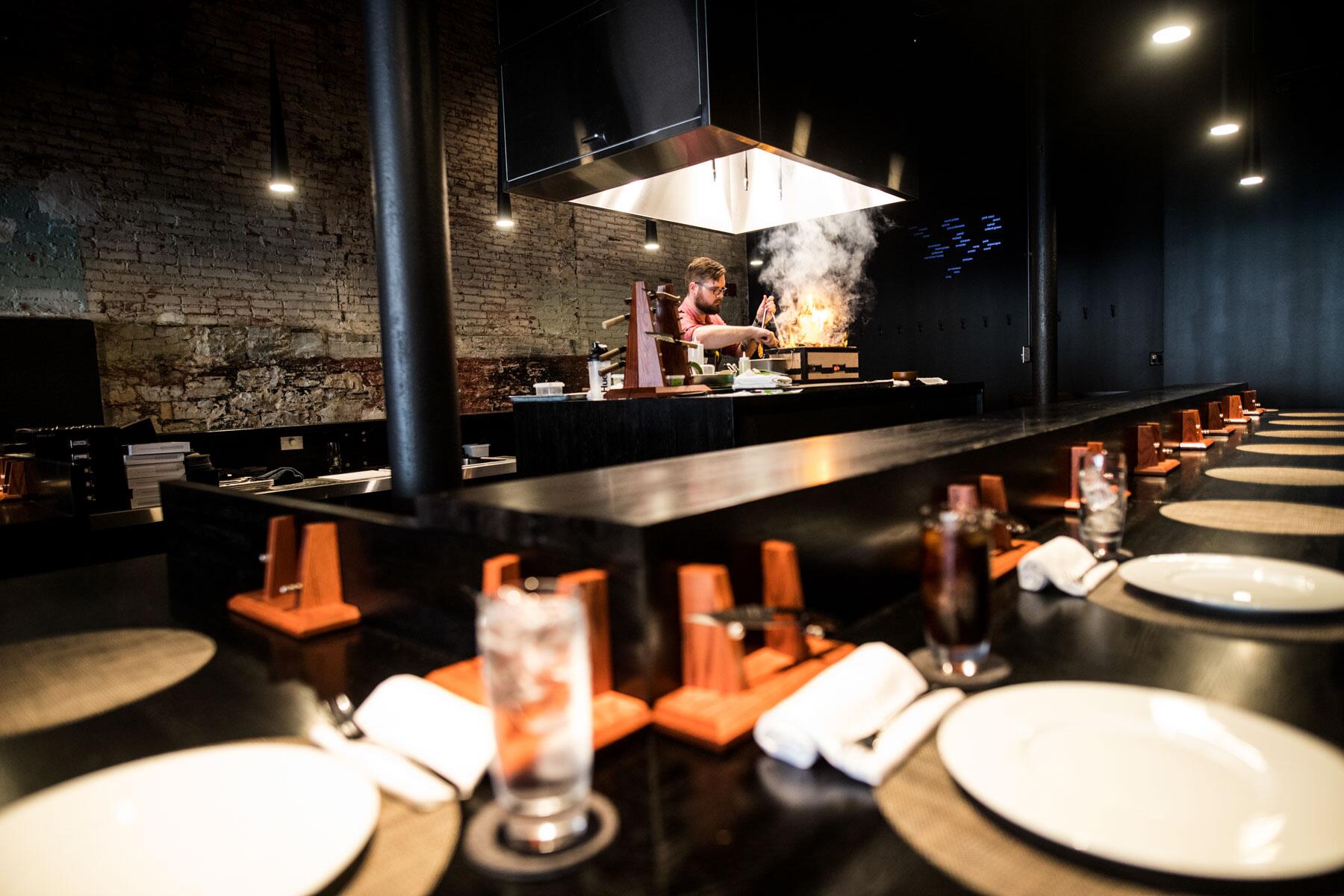One chef brings a traditional menu to a contemporary restaurant.
Deep among the dense forests of the Ozarks, thick with maple and oak trees, dangling vines, and rushing rivers, lie buried treasures for the kitchen.
During the harshness of the region’s seasons, from its steamy summers to its bitterly cold winters, Chef Rob Connoley can be found collecting regional bounties like pawpaw, spicebush berries, morels, and chanterelles beneath spider webs and fallen limbs for his St. Louis restaurant, Bulrush. A deep and intentional exploration of the land has shaped Connoley’s gastronomic work from its earliest imaginings.
The dawn of his culinary career unfolded in the high desert of New Mexico, where he foraged the arid landscapes dotted with prickly pear and mesquite cactus and on land abundant in Ponderosa pines for food sources like tree barks, currants, and hackberries. While the region and landscapes may have changed from New Mexico to the Ozarks, the ethos behind Connoley’s culinary work has remained steadfast.

Rob Connoley moves with the ebb and flow of the seasons, intimately intertwined with the regional ecosystems. Foraging in the depths of local landscapes is just a small part of Connoley’s innovative culinary approach, however. His restaurants are the backdrop to a much deeper goal: authentic storytelling that honors a region’s culture and history and pays homage to its stewards, coupled with zero-waste policies. And at the core of Connoley’s culinary creativity? Curiosity, integrity, and humility.
Recommended Fodor’s Video
This James Beard-nominated chef didn’t follow a traditional route into the culinary world. A Ph.D. in sports psychology was followed by work at a university in Colorado, a stint in rock climbing in Peru, and eventually, non-profit work. Eager to return to the mountains, Connoley found himself in rural New Mexico working in health care access for the uninsured and eventually opened up a meth treatment program. All of these endeavors predated Connoley’s slow gravitation toward food. While living in their adopted hometown of Silver City, New Mexico, Connoley and his partner noticed a distinct cavity in quality food—and thus, also the opportunity to explore gastronomic pursuits.
The drive to bring interesting food to Silver City started as a wine and cheese club, which eventually turned into hosting multi-course pop-up dinners. At this point, Connoley had never worked a day in his life at a restaurant. “I was teaching myself how to do pastry and specifically chocolate. Most of my pastry training was getting Pierre Herme cookbooks and cooking my way through them.” Pop-up dinners turned into a gourmet grocery store and eventually a café. This small lunchtime establishment soon evolved into an up-scale restaurant, the now-closed Curious Kumquat, which drew visitors from far and wide to this unassuming town.
The tasting menu at the Curious Kumquat was largely driven by foraged ingredients from the high desert in New Mexico. New to foraging at the time, Connoley consulted an Indigenous man whom he met in a sweat lodge in New Mexico. “He lived exclusively on the land and ended up bringing an Indigenous perspective, which is nurturing and respectful of the land, instead of a consumption model.” The concept of eating local was new at the time, and Connoley grappled with questions like “What does it mean to shop local?” and “Why are we doing this?” Hyperlocal foraged food followed Connoley to his second and current restaurant, Bulrush, a fine dining restaurant in the heart of St. Louis and an ode to 18th and 19th-century Ozark cuisine.
Born and raised on the outskirts of St. Louis, Missouri, Connoley left after high school in search of the mountains and had no intention of returning. So a challenge lay ahead of Connoley when he moved back to St. Louis to care for his elderly mother in 2016. He knew that he wanted to shape his next restaurant around foraged, local food but was unsure how to fit Midwestern food traditions into the story. Connoley’s research and determination to uncover and comprehend the culinary underpinnings of Missouri and the Ozarks—a forested region that extends from Kansas to Arkansas—slowly sculpted the foundation for Bulrush.
Lacking fond memories of food from his childhood, Connoley’s curiosity led him on countless trips to libraries and research institutes across the greater Ozark region. He started at Springfield Missouri Public Library searching through the 1940s and 50s era cookbooks featuring recipes like squirrel casserole. Eventually, he found himself at the Butler Center for Arkansas Studies in Little Rock, where he stumbled across family journals from settlers in the Ozarks during the 1800s.
“These letters talk about food, hunting, agriculture,” said Connoley. “And I thought, ‘Wouldn’t it be fun to tell their story, interpreting what they say, which is very modest, and translate that into something contemporary and exciting’? I realized no one knew what Ozark food was…no one viewed it as worthy of study or a big enough topic.”

And thus, the foundation for Bulrush came to fruition. Currently, Connoley works side-by-side with Missouri-area historians to continually deepen his understanding of Ozark gastronomy. Seed store inventory lists have provided insight to produce consumed during the time, and alongside scientists, Connoley is working to resurrect forgotten seeds from this list, including a variety of watermelon species. To source the ingredients, Connoley works with upwards of 30 local farmers and gardeners. No ingredient is put on the menu without research and verification that it was, indeed, present during this time period in the Ozarks. For example, a tip from a customer confirmed that goats were used in wildfire prevention in the 1800s in the area, after which goat meat and goat cheese were incorporated into the menu.
From week to week, month to month, and season to season, the dining experience varies as the menu stays in sync with the seasonal ingredients available. About 100 dishes are rotated through the menu each year, with about two new dishes each week. Beyond the seasonal offerings, the menu incorporates elements of the kitchen’s experimentation with food scraps. For example, parsnips were part of a winter menu many months back. The parsnip scraps were turned into miso with koji, salt, and several months of aging. That parsnip miso was then infused into ice cream and caramel to be used in dishes served the following summer.
The moment one steps through the doors of Bulrush, they’re transported back in time. Every element of the minimalistic space is intentional and a reflection of Connoley’s commitment to authentic storytelling. Historic cookbooks and Ozark pottery line the shelves, and through the multifarious influences on the food and drink menus, diners journey back to the plains of the 18th and 19th century Ozarks—the point in time when the Indigenous Osage people first encountered the European settlers. The menu isn’t intended to be a literal representation of the region’s cuisine. Rather, the ever-changing tasting menu at Bulrush is inspired by local ingredients and regional traditions of the time that are elevated and celebrated using contemporary techniques.
“It’s that contemporary dish that is connected to the past,” noted Connoley. “That combination has become so important to us. Every dish we serve has to hit that note.”
Each of the seven courses is presented with a backstory, followed by an opportunity to listen to a short video that provides insight into the inspiration behind the dish. First up is a petite acorn explosion that burst in the mouth, followed by a savory apple tartine simmered in vegetable broth and layered with a seed medley and miso parsnip ice cream—an ode to the once-booming apple industry in the Ozarks during the 19th century. Each successive course combines hyperlocal ingredients with roots in different cultural heritages of the Ozark region.
Next up, a roasted beet served atop a bed of on a bed of ground fennel and cauliflower, filled with creamy, earthy goat cheese that spills out as my fork cuts into the deep magenta flesh. A twist on “peas and carrots” includes grilled carrots, millet, and chickpea French fries infused with carrot juice, inspired by an 1865 letter, which “talked about something so mundane as peas and carrots.” Seared catfish is layered on a bed of potatoes, topped with fennel and pickled okra, and drizzled with a creamy, spice-forward tomato sauce; a reinvention of the fried catfish, a fish native to the rivers of the Ozarks, and a twist on the North African chimera stew, a nod to African roots in the region. For the main course, confit turkey is served on a bed of wheatberry, collard greens, and chard and drizzled with a beetroot mole, a way to use the leftover centers from the earlier beet dish. And for dessert? Roasted peaches with yaupon custard, sunflower seeds, and peach glace arranged in a half-moon, highlighting the only caffeinated plant indigenous to North America.

Bulrush’s bar menu is as carefully executed as the food, whisking diners to the likes of St Louis’ most frequented bars of the 19th century. The creative concoctions draw inspiration from inventory lists—featuring heavy orders of absinthe—and celebrate cocktail connoisseurs of the time like Thomas Bullock, an African American mixologist and one of the most recognized bartenders in the United States at the turn of the 20th century. Bullock was famous for his strong punches and his juleps. Rum, bourbon, honey vinegar, and lemongrass yaupon kombucha blend together for a potently delicious cocktail. Apple brandy, dandelion amaro, absinthe, and various house-made liquors are other feature additions to the drinks. Alongside the cocktails is a line-up of French ciders—a nod to the once vibrant apple orchards in the Ozarks—and wines from French vineyards that were saved by Missouri grapevine stocks during the phylloxera crisis of the late 19th century.
By paying tribute to the region around him, Connoley is trying to shift not only the perception of Ozark cuisine but around the fine dining experience at large. He strives to move away from the association of fine dining with an extensive array of global ingredients and instead focuses on “holding local ingredients up to something special.”
Connoley’s work to become zero-waste is another element that should be normalized in fine dining and everyday restaurants alike. “Usually, a restaurant of our size would produce around 40 gallons of waste every night. This is food that would go straight to the trash. For us, we average five gallons of compost each week. Food in the trash is virtually nil. We are trying to redefine fine dining here.”
Perhaps most important to Connoley is quietly honoring and paying back the communities which inspired and contributed to Bulrush, directly or indirectly. He continues to ask himself questions like, “How do I, as a white chef, address the Indigenous people and the enslaved?” and, “What does it mean to be a chef and make money on someone else’s culture?” Ongoing projects, including the Seed Project, Peter Corn Genealogy Project, and the Bar Project, are all extensions of Connoley’s commitment to the community and the continual evolution and understanding of his gastronomic storytelling of the historic Ozarks. Bulrush is much more than simply a restaurant. It is a celebration of the many players in Ozark history, and Connoley is its culinary curator and custodian.




